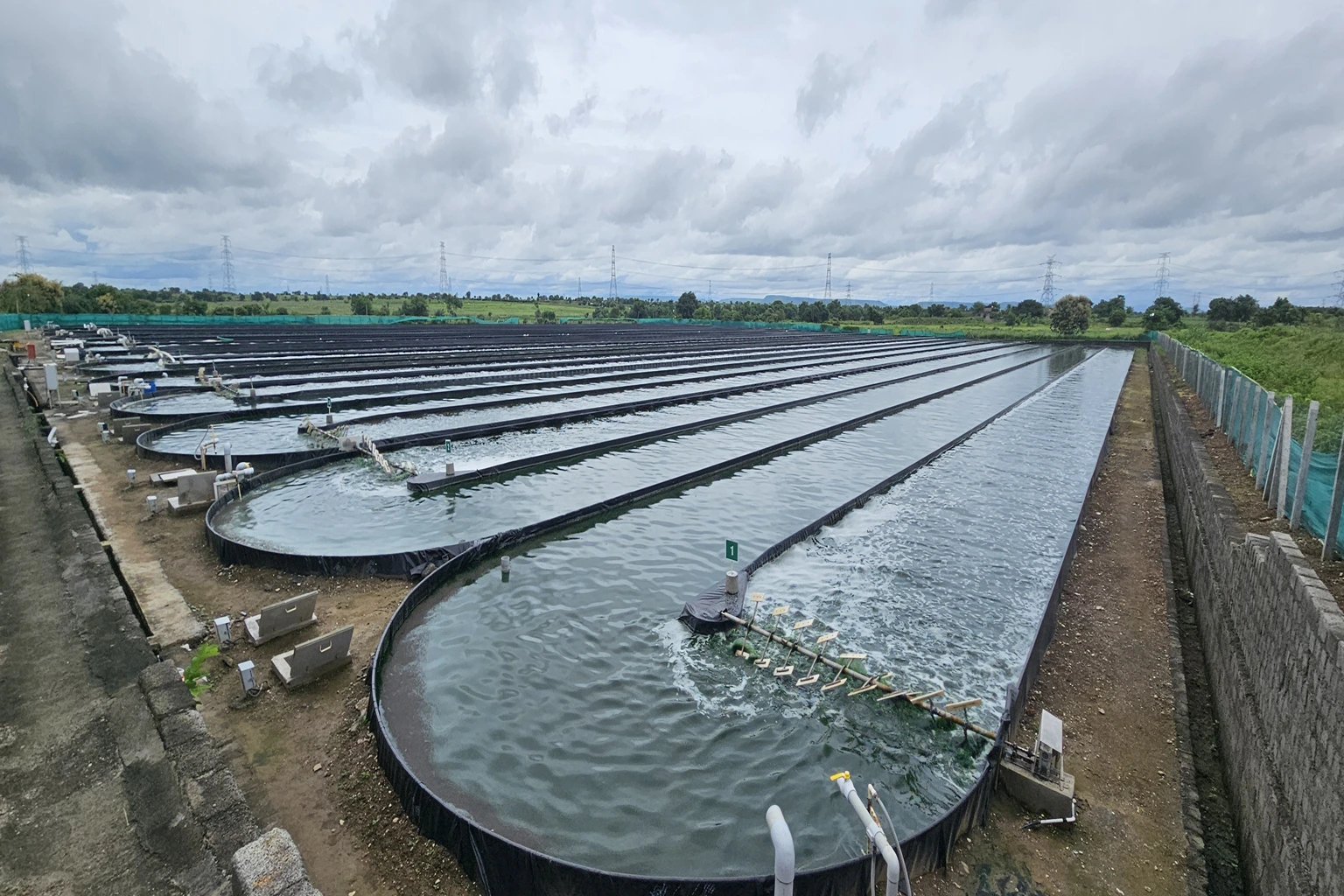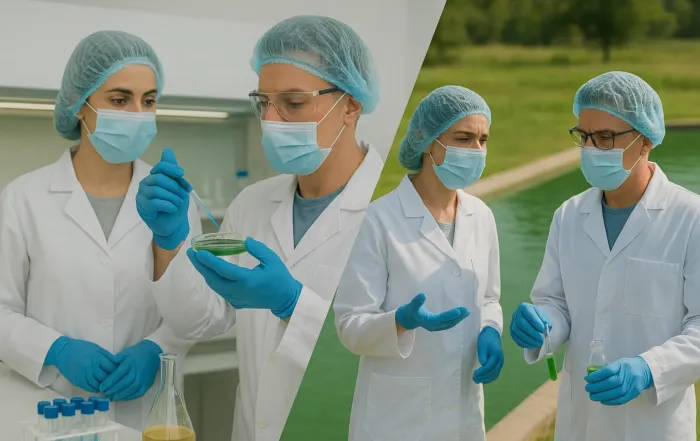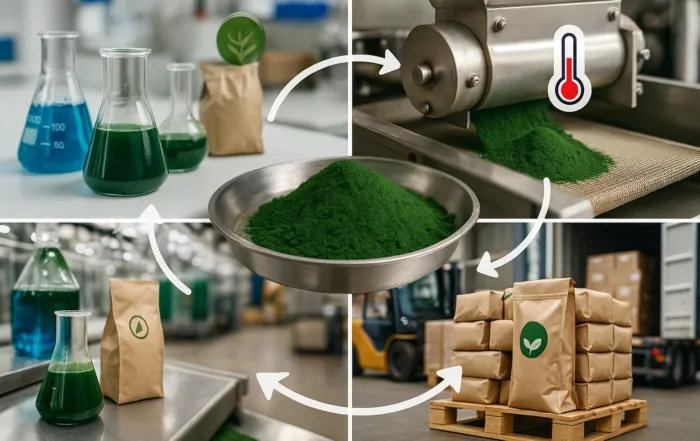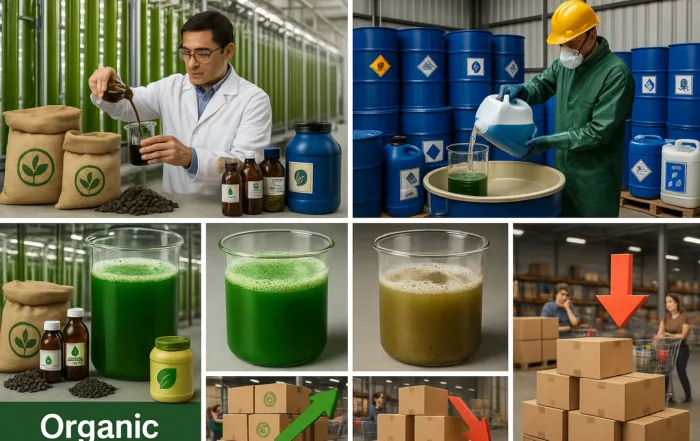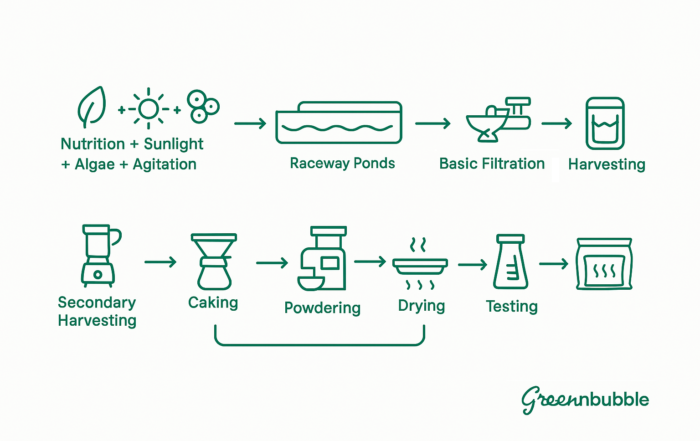In spirulina farming, the raceway pond is the engine room of biomass production. An efficient raceway system determines not just your yield-but also your ability to stay compliant with organic certification, minimize contamination, reduce manual labor, and implement automation. These shallow, paddle-agitated raceways are designed for uniform mixing, temperature control, and light penetration, making them essential for nutrient uptake and pigment formation.
This blog dives deep into how to build a commercial-scale spirulina raceway pond system. Whether you’re setting up a 1-acre farm or scaling beyond, the design decisions you make at this stage influence long-term sustainability, product quality, and market competitiveness.
What Is a Spirulina Raceway Pond?
A raceway pond is a looped, shallow, artificially constructed channel where spirulina culture is kept in constant motion. It mimics a gentle stream using paddle wheels to create unidirectional flow, ensuring that nutrients, light, and temperature are evenly distributed.
These raceways are typically outdoors, but some high-end installations feature greenhouse or semi-covered systems to manage weather fluctuations.
Key Dimensions:
- Length: 10 to 150 meters
- Width: 5 to 20 mtrs
- Depth: 0.25 to 0.35 meters (shallower depth enhances gas exchange and light exposure)
View our raceway pond equipment solutions for turnkey setups.
Core Components of a Spirulina Raceway System
1. Pond Lining
- Use food-grade HDPE or RCC with a smooth finish to prevent algae adherence.
- Must be chemically inert, UV-stable, and free from toxic leachates.
- Potability certified liners are required for certification
2. Agitation System (Paddle Wheel)
- Keeps spirulina in suspension and promotes even exposure to light and nutrients.
- Ideal speed: 20–30 rpm based on pond length
- Stainless steel shafts and energy-efficient motors are preferred.
- Motorized and solar-hybrid paddle wheels reduce operating costs.
3. Water Source and Inlet System
- Use borewell water filtered through RO or sand-carbon systems.
- Inlet pipes should be connected with mesh screens to prevent entry of insects or debris.
4. Nutrient Distribution Port
- Dosing should be done near the paddle wheel for even mixing.
- Use calibrated dosing tanks or venturi injectors for accuracy.
- Avoid adding nutrients manually without measuring pH or conductivity.
5. Drainage and Harvesting Ports
- Design ponds with a gradual slope (1–2%) to facilitate full drainage.
- Valve-controlled outlets should be easy to access and clean.
Raceways and Organic Compliance
Building a certified organic raceway involves more than just material selection. Your infrastructure and protocols must be audit-ready.
Organic Certification Requirements:
- Construction using potability certified HDPE or RCC
- Paddle wheel and gear assembly must be free from lubricants that could leach
- Quarterly water quality testing for heavy metals and microbial load
- No PVC liners, exposed adhesives, or synthetic sealants
Automating the Raceway Workflow
Automation isn’t a luxury—it’s essential for consistency and scale. Smart sensors and control systems enhance productivity and reduce reliance on manual observation.
IoT and Automation Tools:
- pH, temperature, and conductivity sensors: Installed inside raceways, integrated with alarms
- Auto paddle controllers: Speed varies based on time of day and nutrient load
- SCADA dashboard systems: Provide real-time monitoring and data logs
- Dosing automation: Linked with culture parameters to avoid overfeeding or underfeeding
These tools not only ensure consistent growth conditions but also help in generating traceability records required during organic audits.
Internal link: Explore our blog on automation in spirulina farming
Contamination Prevention in Raceways
Contamination is a major risk in outdoor systems. A well-designed raceway system includes features that reduce microbial, insect, and algal contamination.
Preventive Measures:
- Install 80-mesh pre-filters on all water inlets
- Use insect nets or greenhouse roofing to block vectors like midges and flies
- Weekly scrubbing of pond walls with food-grade disinfectants
- Avoid stagnation by running paddle wheels even during nutrient downtime
- Establish biosecurity zones with foot baths and protective clothing
Cost Breakdown for Raceway Setup (1-Acre Farm)
| Component | Estimated Cost (INR) |
| Pond Construction (20) | ₹20–25 Lakhs |
| Agitation Systems | ₹3–4 Lakhs |
| Sensors & Controls | ₹6–8 Lakhs |
| Plumbing & Drain Ports | ₹2–3 Lakhs |
| Testing & Lab Setup | ₹8–9 Lakhs |
| Protective Covers/Nets | ₹2–3 Lakhs |
| Total Setup Cost | ₹45–55 Lakhs |
Note: Automation packages, solar integration, and backup power systems are not included but are highly recommended.
Best Practices for Raceway Efficiency
- Use SS 316-grade components in all water-contact areas
- Monitor turbidity, nutrient depletion, and pigment levels weekly
- Maintain the C:N:P ratio of 24:0.14:1 to boost biomass growth
- Avoid over-agitation; use variable speed motors for control
- Conduct routine paddle alignment checks to reduce energy wastage
- Regularly calibrate sensors to ensure data accuracy
Training and Staff Protocols:
- Train operators to detect culture discoloration and foam formation
- Create checklists for daily raceway inspection
- Rotate ponds periodically for maintenance and cleaning cycles
Real-World Scenario: Poor Raceway Design vs. Optimized Layout
A spirulina farm in Karnataka initially used cement raceways without proper slope or drain points. Biomass collection was inefficient and required manual scooping. Post-redesign with sloped HDPE raceways, paddle-driven harvesting points, and automated dosing, the farm saw:
- 22% increase in biomass yield
- 35% reduction in labor
- Faster draining and cleaning between cycles
Conclusion: A Smart Raceway Design Sets the Foundation
Raceway ponds are the foundation of commercial spirulina farming. Poorly designed raceways lead to inconsistent yields, contamination, and certification challenges. On the other hand, optimized raceways—built with food-grade materials, integrated with smart controls, and aligned with organic compliance—offer superior output and scalability.
Whether you’re launching a 1-acre project or scaling to 5+ acres, investing in the right raceway infrastructure is the first step to building a profitable, export-ready spirulina business.
Need help setting up your raceway system? Check out our raceway pond solutions or contact our team for turnkey assistance.

